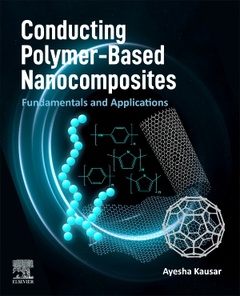Description
Conducting Polymer-Based Nanocomposites
Fundamentals and Applications
Author: Kausar Ayesha
Language: English
Subjects for Conducting Polymer-Based Nanocomposites:
Keywords
Alloys; Analyte; Aniline black; Barrier properties; Biosensor; Bipolarons; Capacitance; Carbazole; Carbon black; Carbon nanotube; Chemical technique; Core-shell; Core-shell; Corrosion resistance; Current density; Deposition; Detection limit; Dielectric losses; Dispersant; Dye-sensitize; Electrical conductivity; Electroactivity; Electrochemical; Electrochemical impedance spectroscopy; Electromagnetic interference; Electropolymerization; Electrospinning; Emeraldine; EMI shielding effectiveness; Fill factor; Gas sensor; Gold; Graphene; Graphene oxide; Humidity; Intercalation; Interfacial bonding; KeywordsNanodispersion; Leucoemeraldine; Lithography; Magnetic permeability; Mechanism; Metals; Microbial fuel cell; Modified graphene oxide; Nanocarbon; Nanoclay; Nanofiber; Nanoparticle; Nanosize effect; Nanostructure; Nanowire; Network; Organo-modified; o-Toluidine; Oxidizing agent; Percolation threshold; Pernigraniline; pH sensor; Photovoltaic; Physical vapor deposition; Polarons; Poly(3-hexylthiophene); Polymerization; Polythiophene derivatives; Power density; Radiation shielding; Rechargeable; Response time; Selectivity; Sensitivity; Silica; Silver; Solar cell efficiency; Sol-gel; Spin coating; Spraying; Steric hindrance; Sulfonated graphene; Template method; Thermoplastic; Thermosetting; Titania; Wear resistance; Whisker method; p-p stacking
306 p. · 19x23.3 cm · Paperback
Description
/li>Contents
/li>Biography
/li>Comment
/li>
Conducting Polymer-Based Nanocomposites: Fundamentals and Applications delivers an up-to-date overview on cutting-edge advancements in the field of nanocomposites derived from conjugated polymeric matrices. Design of conducting polymers and resultant nanocomposites has instigated significant addition in the field of modern nanoscience and technology. Recently, conducting polymer-based nanocomposites have attracted considerable academic and industrial research interest. The conductivity and physical properties of conjugated polymers have shown dramatic improvement with nanofiller addition. Appropriate fabrication strategies and the choice of a nanoreinforcement, along with a conducting matrix, may lead to enhanced physicochemical features and material performance. Substantial electrical conductivity, optical features, thermal stability, thermal conductivity, mechanical strength, and other physical properties of the conducting polymer-based nanocomposites have led to high-performance materials and high-tech devices and applications.
This book begins with a widespread impression of state-of-the-art knowledge in indispensable features and processing of conducting polymer-based nanocomposites. It then discusses essential categories of conducting polymer-based nanocomposites such as polyaniline, polypyrrole, polythiophene, and derived nanomaterials. Subsequent sections of this book are related to the potential impact of conducting polymer-based nanocomposites in various technical fields. Significant application areas have been identified for anti-corrosion, EMI shielding, sensing, and energy device relevance. Finally, the book covers predictable challenges and future opportunities in the field of conjugated nanocomposites.
1. Prominence of conjugated polymers 2. Conducting polymer-based nanocomposites: Structuration, compatibilizing effect, conductivity, and physical properties 3. Essence of nanoparticles and functional nanofillers for conducting polymers 4. Design and development of polyaniline/nanocarbon nanocomposites 5. Perspectives on nanocomposite with polypyrrole and nanoparticles 6. Emerging hybrids derived from polythiophene and graphene 7. Nanocomposite nanofibers of conducting polymers: Multifunctional nanostructured materials 8. Anti-corrosion coatings derived from conducting polymeric nanocomposites 9. Electromagnetic interference shielding effectiveness of polymer nanocomposites 10. Effect of interaction between conjugated polymers and nanofillers on sensing properties 11. Versatile materials for energy devices and systems
Her current research interests include the design, fabrication, characterization, and exploration of the structure-property relationships and potential future prospects for nanocomposites, polymeric nanocomposites, polymeric composites, polymeric nanoparticles, polymer dots, nanocarbon materials (graphene and its derivatives, fullerene, carbon nanotube, fullerene, nanodiamond, carbon nano-onion, carbon nanocoil, carbon nanobelt, carbon nanodisk, carbon dot, and other nanocarbons), hybrid materials, eco-friendly materials, nanocomposite nanofibers, and nano-foam architectures.
- Integrates the fundamentals of conducting polymers and a range of multifunctional applications
- Describes categories of essential conducting polymer-based nanocomposites for polyaniline, polypyrrole, polythiophene, and derivative materials
- Assimilates the significance of multifunctional nanostructured materials of nanocomposite nanofibers
- Portrays current and future demanding technological applications of conjugated polymer-based nanocomposites, including anti-corrosion coatings, EMI shielding, sensors, and energy production and storage devices
These books may interest you

Nanofibers of Conjugated Polymers 135.96 €



